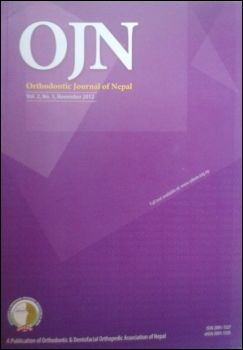Polynomial Analysis of Dental Arch Form of Nepalese Adult Subjects
DOI:
https://doi.org/10.3126/ojn.v3i1.9267Keywords:
arch form, orthodontic, polynomial, sagittal, transverseAbstract
Introduction: Human dental arch acquires stable form and dimensions with the attainment of adulthood. The orthodontic treatment regimen signifies the predetermination of the shape and type of dental arch form of a particular adult population to harmonize with their natural pattern. The use of predetermined arch form helps in diagnosis, treatment planning and stability of orthodontic treatment results.
Objective: To analyze the dental arch forms of Nepalese adults and to classify them into morphological types.
Materials & Method: Predetermined transverse and sagittal dimensions on dental stone models of one hundred Nepalese adults aged 17-32 years with normal occlusion and dentofacial proportion were measured using standardized Boley gauze. The analysis was done according to Raberin’s mathematical sixth degree polynomial method. The study compared the gender difference among the Nepalese samples.
Result: The distribution of the Nepalese arch form types were; 26% flat arch, 24% wide arch, 19% pointed arch, 18% narrow arch and 13% mid arch.
Conclusion: Considerable variation in distribution of dental arch form types found between Nepalese male and female samples and among population groups. The analysis enables the mathematical method that predetermines the dental arch form of the individual orthodontic patient.
DOI: http://dx.doi.org/10.3126/ojn.v3i1.9267
Orthodontic Journal of Nepal, Vol.3, No.1, 2013: 7-13
Downloads
Downloads
Published
How to Cite
Issue
Section
License
Copyright © held by Orthodontic & Dentofacial Orthopedic Association of Nepal
- Copyright on any research article is transferred in full to the Orthodontic & Dentofacial Orthopedic Association of Nepal upon publication in the journal. The copyright transfer includes the right to reproduce and distribute the article in any form of reproduction (printing, electronic media or any other form).
- Articles in the Orthodontic Journal of Nepal are Open Access articles published under the Creative Commons CC BY License (https://creativecommons.org/licenses/by/4.0/)
- This license permits use, distribution and reproduction in any medium, provided the original work is properly cited.




